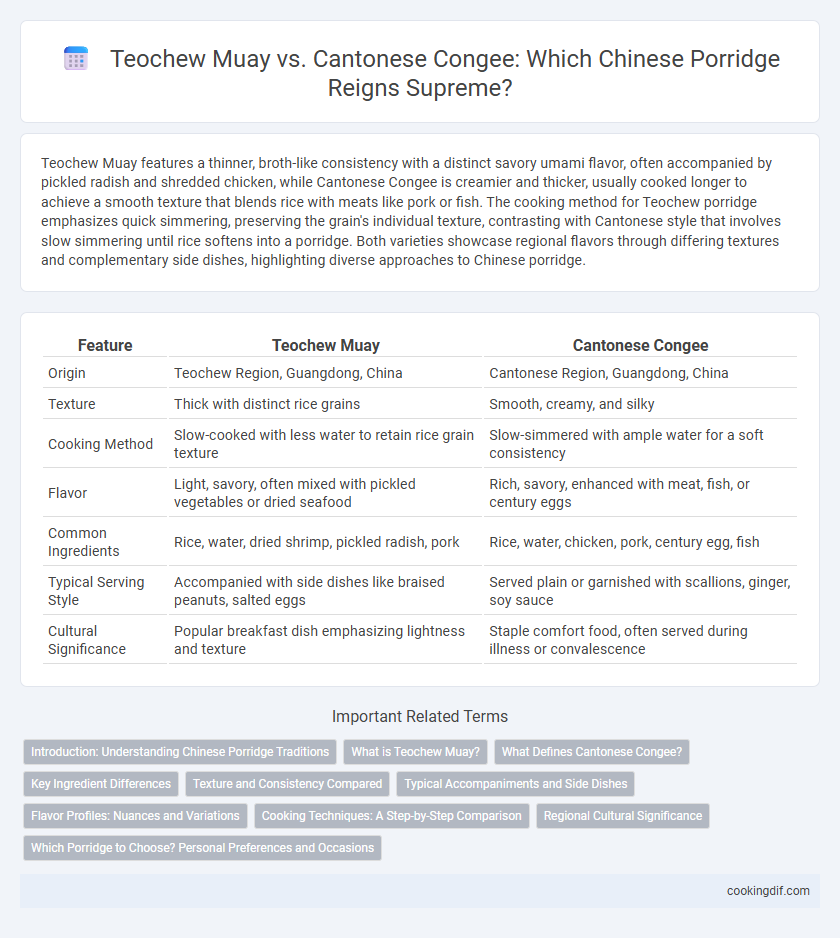Teochew Muay features a thinner, broth-like consistency with a distinct savory umami flavor, often accompanied by pickled radish and shredded chicken, while Cantonese Congee is creamier and thicker, usually cooked longer to achieve a smooth texture that blends rice with meats like pork or fish. The cooking method for Teochew porridge emphasizes quick simmering, preserving the grain's individual texture, contrasting with Cantonese style that involves slow simmering until rice softens into a porridge. Both varieties showcase regional flavors through differing textures and complementary side dishes, highlighting diverse approaches to Chinese porridge.
Table of Comparison
| Feature | Teochew Muay | Cantonese Congee |
|---|---|---|
| Origin | Teochew Region, Guangdong, China | Cantonese Region, Guangdong, China |
| Texture | Thick with distinct rice grains | Smooth, creamy, and silky |
| Cooking Method | Slow-cooked with less water to retain rice grain texture | Slow-simmered with ample water for a soft consistency |
| Flavor | Light, savory, often mixed with pickled vegetables or dried seafood | Rich, savory, enhanced with meat, fish, or century eggs |
| Common Ingredients | Rice, water, dried shrimp, pickled radish, pork | Rice, water, chicken, pork, century egg, fish |
| Typical Serving Style | Accompanied with side dishes like braised peanuts, salted eggs | Served plain or garnished with scallions, ginger, soy sauce |
| Cultural Significance | Popular breakfast dish emphasizing lightness and texture | Staple comfort food, often served during illness or convalescence |
Introduction: Understanding Chinese Porridge Traditions
Teochew Muay porridge is characterized by its watery texture and emphasis on fresh seafood, reflecting the coastal influences of the Chaoshan region. Cantonese congee features a thicker consistency with rice grains often fully broken down, offering a smooth and hearty base typically paired with diverse preserved meats and century eggs. Both variations highlight regional ingredients and culinary customs, showcasing the rich diversity within Chinese porridge traditions.
What is Teochew Muay?
Teochew Muay is a distinct style of Chinese porridge originating from the Teochew region, characterized by its watery texture and a variety of savory accompaniments such as pickled vegetables, peanuts, and seafood. Unlike Cantonese congee, which is thicker and often cooked until the rice grains almost dissolve, Teochew Muay maintains a looser consistency with individual rice grains visible, offering a lighter and more refreshing taste. This porridge emphasizes subtle flavors and a delicate broth, making it a staple in Teochew culinary tradition and favored for breakfast or light meals.
What Defines Cantonese Congee?
Cantonese congee is defined by its smooth, creamy texture achieved through slow simmering of rice and a higher water-to-rice ratio compared to Teochew muay, resulting in a thick, porridge-like consistency. It often includes savory additions such as century eggs, pork, and dried seafood, offering a rich umami flavor. The dish emphasizes subtle seasoning to highlight the natural taste of ingredients, distinguishing it from the more broth-heavy and chunkier Teochew muay style.
Key Ingredient Differences
Teochew Muay porridge features a watery consistency with preserved vegetables and minced pork, emphasizing light seasoning and clear broth. Cantonese congee is thicker, often cooked longer to a creamy texture, incorporating ingredients like century eggs, salted duck eggs, and often garnished with scallions and ginger. The key ingredient differences highlight Teochew's use of preserved radish and lean meats versus Cantonese's richer, more diverse toppings and thicker rice base.
Texture and Consistency Compared
Teochew Muay porridge features a smooth, watery texture with rice grains that are soft yet distinct, creating a light and easily digestible consistency. Cantonese congee is thicker and creamier, achieved by prolonged simmering that breaks down rice grains into a velvety, porridge-like consistency. The key difference lies in Teochew's more broth-like fluidity versus Cantonese's rich, pudding-like texture.
Typical Accompaniments and Side Dishes
Teochew Muay porridge is typically served with fresh seafood, such as salted egg, fish slices, and preserved radish, emphasizing light and delicate flavors. Cantonese congee often includes richer side dishes like century eggs, pork floss, and fried dough sticks (youtiao), offering a heartier and more savory experience. Both variations highlight cultural preferences, with Teochew favoring subtle seafood accompaniments and Cantonese featuring robust, meaty side dishes.
Flavor Profiles: Nuances and Variations
Teochew Muay offers a lighter, more delicate flavor with a subtle savory undertone accented by fresh ingredients like preserved vegetables and seafood. Cantonese Congee features a richer, creamier texture with robust savory notes often enhanced by meats such as pork and century eggs, creating a hearty and comforting taste. Both variations highlight regional preferences in spice, seasoning, and ingredient combinations that define their unique flavor profiles within Chinese porridge traditions.
Cooking Techniques: A Step-by-Step Comparison
Teochew Muay porridge involves slow simmering rice with a high water-to-rice ratio, yielding a smooth, watery consistency enhanced by frequent stirring to release starch. Cantonese congee employs a longer cooking time with intermittent boiling and occasional stirring, creating a thicker, creamier texture as the rice grains break down more thoroughly. Both methods emphasize precise control of heat and timing, yet Teochew Muay prioritizes lightness while Cantonese congee achieves rich viscosity through gradual reduction.
Regional Cultural Significance
Teochew Muay and Cantonese Congee reflect distinctive regional cultural significance within Chinese porridge traditions. Teochew Muay, valued for its thin, watery texture and delicate seafood flavor, highlights the coastal influences and refined culinary heritage of the Teochew region. Cantonese Congee, often thicker and creamier with preserved meats and century eggs, embodies the hearty, comfort-food essence deeply rooted in Cantonese family dining customs.
Which Porridge to Choose? Personal Preferences and Occasions
Teochew Muay porridge, known for its smooth texture and subtle flavors, offers a lighter option ideal for breakfast or delicate palates. Cantonese congee presents a thicker, richer consistency often combined with savory ingredients, perfect for comforting meals or special occasions. Choosing between these depends on personal taste preferences and the desired dining context, with Teochew favored for simplicity and Cantonese for heartiness.
Teochew Muay vs Cantonese Congee for Chinese Porridge Infographic

 cookingdif.com
cookingdif.com